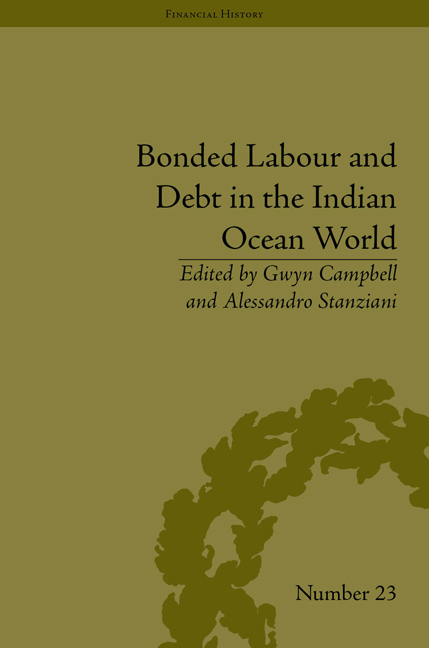Book contents
- Frontmatter
- Contents
- Acknowledgements
- List of Contributors
- Introduction
- 1 Debt and the Coercion of Labour in the Islamic Legal Tradition
- 2 Debt, Pawnship and Slavery in Nineteenth-Century East Africa
- 3 Debt and Slavery in Imperial Madagascar, 1790–1861
- 4 Credit and Debt in the Lives of Freed Slaves at the Cape of Good Hope: The Case of Arnoldus Koevoet, 1697–1735
- 5 Debt, Labour and Bondage: English Servants versus Indentured Immigrants in Mauritius, from the Late Eighteenth to Early Twentieth Century
- 6 Ransom, Escape and Debt Repayment in the Sulu Zone, 1750–1898
- 7 Debt and Slavery among Arabian Gulf Pearl Divers
- 8 The Political Economy of Debt Bondage in Contemporary South India
- 9 The Name of the Slave and the Quality of the Debt: When Slaves Are Not Debtors and Debtors Are Not Slaves in the Family Narrative of a Filipina Comfort Woman
- 10 Two Bonded Labour Emigration Patterns in Mid-Nineteenth-Century Southern China: The Coolie Trade and Emigration to Southeast Asia
- 11 Debt Slaves in Old Korea
- 12 The Debt-Servitude of Prostitutes in Japan during the Edo Period, 1600–1868
- Notes
- Index
10 - Two Bonded Labour Emigration Patterns in Mid-Nineteenth-Century Southern China: The Coolie Trade and Emigration to Southeast Asia
- Frontmatter
- Contents
- Acknowledgements
- List of Contributors
- Introduction
- 1 Debt and the Coercion of Labour in the Islamic Legal Tradition
- 2 Debt, Pawnship and Slavery in Nineteenth-Century East Africa
- 3 Debt and Slavery in Imperial Madagascar, 1790–1861
- 4 Credit and Debt in the Lives of Freed Slaves at the Cape of Good Hope: The Case of Arnoldus Koevoet, 1697–1735
- 5 Debt, Labour and Bondage: English Servants versus Indentured Immigrants in Mauritius, from the Late Eighteenth to Early Twentieth Century
- 6 Ransom, Escape and Debt Repayment in the Sulu Zone, 1750–1898
- 7 Debt and Slavery among Arabian Gulf Pearl Divers
- 8 The Political Economy of Debt Bondage in Contemporary South India
- 9 The Name of the Slave and the Quality of the Debt: When Slaves Are Not Debtors and Debtors Are Not Slaves in the Family Narrative of a Filipina Comfort Woman
- 10 Two Bonded Labour Emigration Patterns in Mid-Nineteenth-Century Southern China: The Coolie Trade and Emigration to Southeast Asia
- 11 Debt Slaves in Old Korea
- 12 The Debt-Servitude of Prostitutes in Japan during the Edo Period, 1600–1868
- Notes
- Index
Summary
This chapter compares two types of bonded labour emigration, the coolie trade and emigration to Southeast Asia, and reconsiders the reasons for the decline of the former. Given the global expansion of migration, interest in emigration throughout history has increased, and the Chinese diaspora has recently also begun to attract more scholarly attention. However, work on the coolie trade, which became a research focus in the field of Chinese modern history by the 1980s, has declined because of the shift in interest from the coolie trade to Chinese emigration to Southeast Asia and North America. Nonetheless, many aspects of this trade have received attention. For example, P.C. Campbell's Chinese Coolie Emigration to Countries within the British Empire (1923) considered the coolie trade in the British Empire, while E. C. Arensmeyer in ‘British Merchant Enterprise and the Chinese Coolie Labour Trade 1850-1874’ (1979) studied the role of the British government in the coolie trade and its relation- ship with British merchants. Qing government policy against the coolie trade has also attracted the attention of scholars. Furthermore, the emigration system, resistance against the coolie trade and the rescue of kidnapped persons have already been analysed, along with the situation in the area of immigration.
However, although many scholars have studied this topic, some issues remain Unexamined.
- Type
- Chapter
- Information
- Bonded Labour and Debt in the Indian Ocean World , pp. 153 - 164Publisher: Pickering & ChattoFirst published in: 2014



